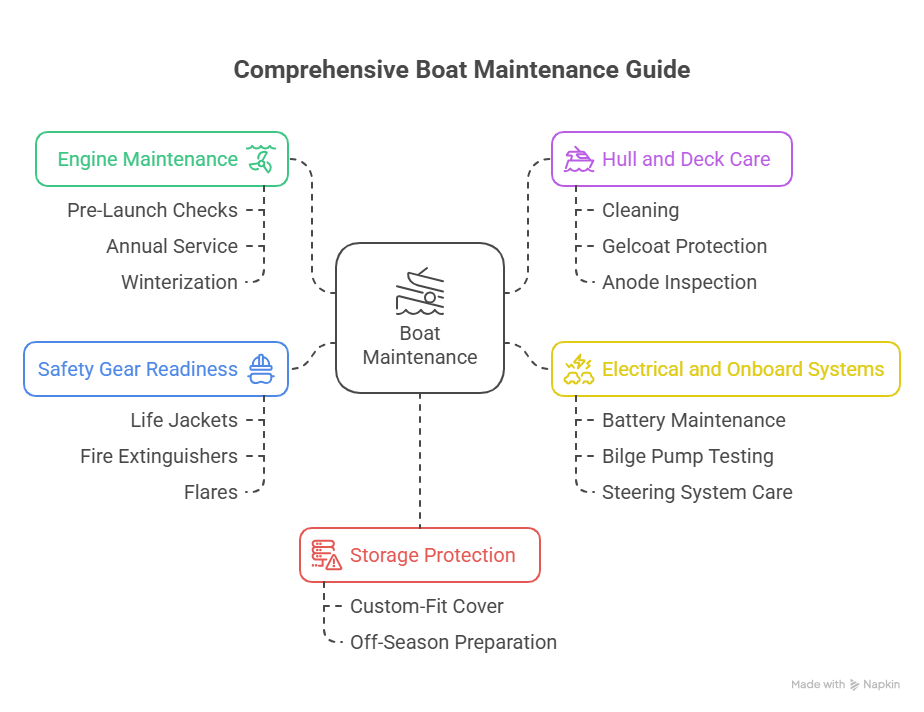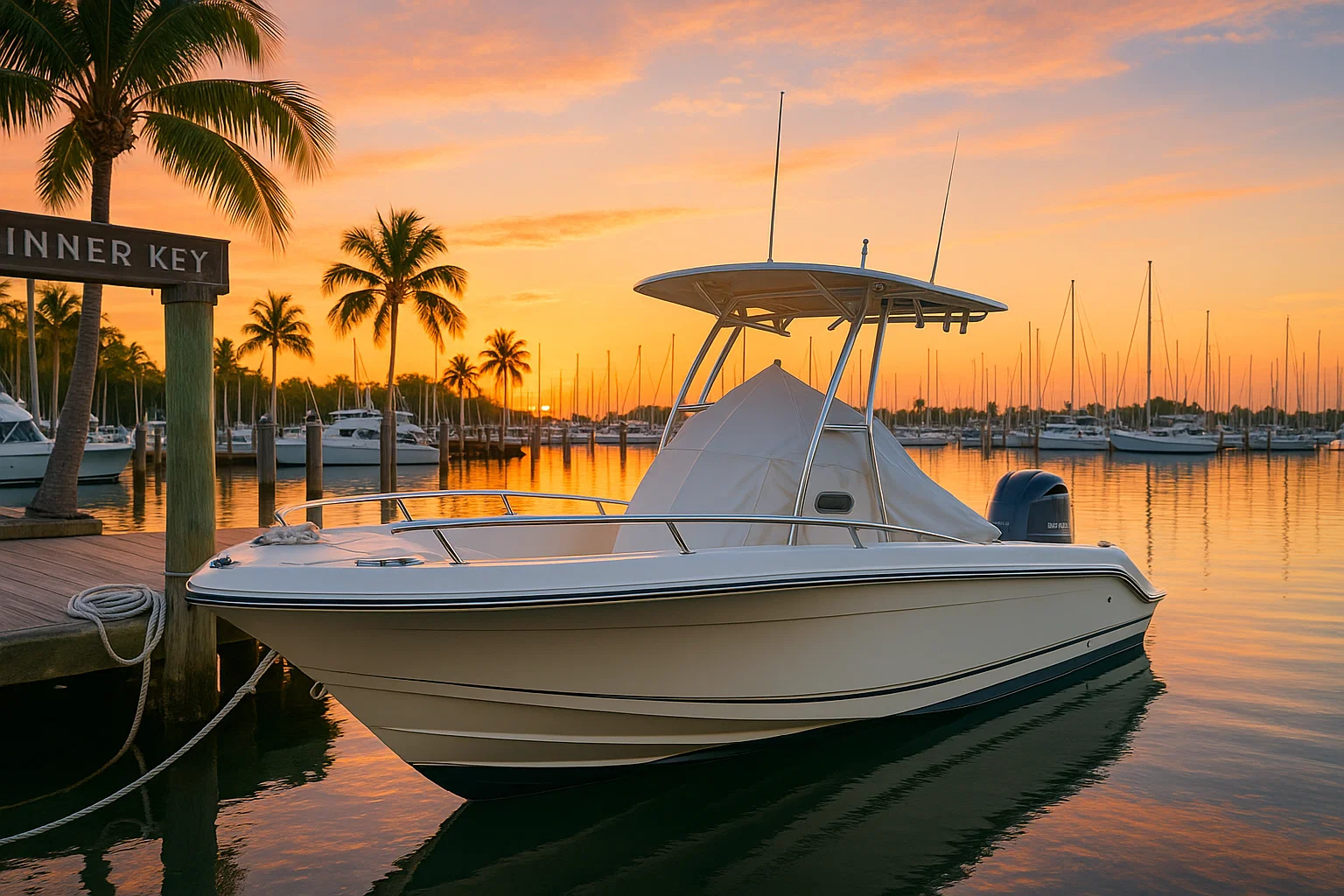How to Take Care of a Boat: 15 Years of Lessons from Miami’s Marinas
I’ve been wrenching on boats in South Florida for 15 years, starting as a kid helping my dad fix Mercurys in our Fort Lauderdale garage. Last June 2024, a buddy named Carlos brought his Sea Ray 230 to Dinner Key Marina—his engine wouldn’t start after sitting all winter. A quick check showed gunked-up fuel from bad storage, costing him $600 to fix. That’s the kind of headache I help boaters avoid. Here’s my no-nonsense guide to keeping your boat ready for every adventure, built from years of fixing other people’s mistakes.
Why Does Boat Maintenance Matter?
A well-maintained boat means more time cruising and less time stuck at the dock. I’ve seen folks lose entire weekends to preventable issues—dead batteries, clogged bilge pumps, you name it. Regular care protects your investment, keeps you safe, and saves you from $1,000+ repair bills. My approach isn’t a chore list; it’s a rhythm that keeps your vessel reliable. Let’s break it down into practical habits you can start today.
Building Your Maintenance Rhythm: The Foundation of Boat Care
Boat care isn’t about endless tasks—it’s about a proactive rhythm that catches issues early. I learned this from an old mechanic named Ray in 2010, who swore by a logbook to track everything. It’s saved me from missing critical checks, like the time I caught a failing impeller on my Boston Whaler before it cooked the engine.
How Do I Create a Personalized Maintenance Schedule?
Start with a simple logbook or phone app. Divide tasks into pre-trip, monthly, and annual checks. For my Whaler, I check fuel and oil before every outing, inspect zincs monthly, and do a full engine service yearly. Tailor it to your boat—saltwater boats like those in Miami need extra corrosion checks. This rhythm stops small issues from becoming $2,000 repairs.
What’s in a Pre-Launch Checklist?
Before casting off, spend five minutes on these:
- Oil: Pull the dipstick; it should be amber, not black or milky.
- Fuel: Keep a one-third reserve and check lines for cracks.
- Propeller: Look for dings or fishing line—minor damage can wreck your drivetrain.
- Safety Gear: Test life jackets, flares, and fire extinguishers.
Last month at Stiltsville, a guy’s prop was chipped, causing vibrations that cost $800 to fix. Five minutes could’ve saved him.
Why Is the Manufacturer’s Manual Critical?
Your manual’s the bible for your boat—mine’s dog-eared from years of use. It’s got exact specs for oil types, torque settings, and service intervals. I once skipped a manual’s impeller interval and paid $500 for an overheat fix. Keep it handy and follow its guidance over generic advice.
How Do I Keep My Hull and Deck in Top Shape?
Your hull’s your boat’s armor—neglect it, and you’re asking for trouble. I’ve seen boats at Bahia Mar with cracked gelcoats from ignored scratches, leading to $3,000 repairs. Regular care keeps your boat performing and looking sharp.
How Often Should I Clean My Hull?
Wash the deck and topsides after every saltwater trip with marine soap to avoid stripping wax. Below the waterline, a clean hull cuts drag, saving fuel. I scrub my Whaler’s bottom monthly with a soft brush—takes 20 minutes and boosts speed by 10%. For in-water boats, apply anti-fouling paint yearly; I saw a guy’s Grady-White lose 15% efficiency from barnacles.
What’s the Best Way to Protect My Gelcoat?
Polish to fix oxidation, wax to protect. I wax my boat every spring with Star brite—it blocks UV rays and keeps the gelcoat glossy. Check for spider cracks monthly; a client at Key Biscayne ignored one and faced a $1,200 repair. Quick fixes with marine sealant save big bucks.
How Do I Inspect Sacrificial Anodes?
Zincs protect underwater metals from galvanic corrosion—critical in Miami’s salty marinas. I check mine monthly, replacing them when half-gone. Last summer, a client’s neglected zincs led to a $2,500 prop shaft repair. It’s a $20 part—don’t skip it.
How Do I Maintain My Boat’s Engine?
Your engine’s the heart of every adventure. I’ve rebuilt 200+ engines fried from neglect, like a Yamaha 200 at Coconut Grove last year. Consistent checks keep you on the water, not calling for a tow.
What Should I Check Before Launching?
Run this five-minute drill:
- Oil: Ensure it’s at the “full” mark and clean.
- Fuel System: Inspect for leaks; I use a flashlight to spot cracks.
- Prop: Check for damage—saved a guy $1,000 by catching a bent blade.
- Belts/Hoses: Look for cracks or loose clamps.
A client at Fort Lauderdale’s marina skipped this and paid $1,500 for a fuel pump fix.
Why Is Annual Engine Service Crucial?
Change oil and filters before winter storage—it removes corrosive gunk. I use Pennzoil Marine 10W-30; a $50 job saved a client’s Mercury 150 from $4,000 damage. Swap fuel filters and check the impeller yearly—mine failed once, and the overheat cost $600. Follow your manual’s intervals, not guesses.
How Do I Winterize My Engine?
In colder climates, winterizing prevents freeze damage. My checklist: add fuel stabilizer, flush with fresh water, run antifreeze through the cooling system, fog cylinders with oil, and change gear lube. I botched this in 2012, costing $2,000. A pro job runs $300–$500 but saves thousands.
How Do I Keep Electrical and Onboard Systems Reliable?
Your electrical and plumbing systems are your boat’s unsung heroes. A dead battery or clogged bilge pump can ruin a trip—I’ve seen it too many times at Miami marinas.
How Do I Maintain My Boat’s Battery?
Battery failure’s a top tow reason. I clean terminals with baking soda monthly—takes five minutes. Last July, a guy’s dead battery at Key Biscayne cost him a $200 tow. Test lights, horns, and detectors before launch; I caught a bad connection on my Whaler last month.
Why Test the Bilge Pump Regularly?
Your bilge pump’s your safety net. I lift the float switch every few trips to ensure it kicks on. A client’s clogged pump failed off Stiltsville, flooding his bilge—$1,000 fix. Keep the bilge clean to avoid clogs.
How Do I Care for Steering Systems?
Check steering monthly. For cables, I lubricate with marine grease; for hydraulics, I check fluid levels. A sticky cable cost a client $400 last spring. Smooth steering’s non-negotiable for safety.

How Do I Ensure Safety Gear Is Ready?
Safety gear’s your lifeline. I make it a ritual to check before every trip—saved me once when a flare signaled a tow off Fort Lauderdale.
What Safety Gear Should I Check?
- Life Jackets: Ensure one per person, no rips.
- Fire Extinguishers: Check gauge and expiration.
- Flares: Verify current dates.
- Horn: Test it.
- First-Aid Kit: Restock annually.
A client’s expired flares led to a $500 fine last year—check dates.
How Do I Maintain Navigation Systems?
Update GPS firmware yearly; I use Garmin’s app for my unit. Check connections for corrosion—common in Miami’s humidity. Keep a compass and paper charts as backups. I navigated manually once when my GPS failed off Key Biscayne.
How Do I Protect My Boat During Storage?
Your boat sits more than it sails. Proper storage prevents damage—UV rays and moisture are killers in South Florida.
Why Use a Custom-Fit Boat Cover?
A custom cover’s my best defense against sun and rain. I use support poles to prevent pooling; a generic cover tore on a client’s boat, costing $800 in upholstery damage. Wax the hull first for extra protection.
How Do I Prepare for Off-Season Storage?
- Clean Thoroughly: Scrub salt and grime—mold’s a nightmare.
- Remove Gear: Store cushions, electronics indoors.
- Choose Storage: Trailers are accessible; racks are secure.
I helped a client winterize his Bayliner last fall—saved him $2,000 in repairs.
FAQ: Common Boat Care Questions
How Often Should I Check My Boat’s Oil?
Check before every trip. I pull the dipstick to ensure it’s amber and full. Last summer, low oil killed a client’s engine—$4,000 fix. Use marine-grade oil like Pennzoil.
What’s the Best Way to Clean a Hull?
Use marine soap after every saltwater trip. I scrub my Whaler’s bottom monthly to cut drag—saves 10% fuel. Anti-fouling paint’s a must for in-water boats.
How Do I Know When to Replace Zincs?
Check monthly; replace when half-gone. I caught failing zincs on a Sea Ray last June, saving $2,500. They’re cheap—$20 each.
Why Is Winterizing Important?
It prevents freeze damage. I flush with antifreeze and fog cylinders—skipped this once and paid $2,000. Costs $300–$500 but saves thousands.
How Do I Test My Bilge Pump?
Lift the float switch every few trips. A clogged pump cost a client $1,000 last year. Keep the bilge clean to avoid issues.
What Safety Gear Do I Need?
Life jackets, fire extinguishers, flares, horn, first-aid kit. I check before every trip—expired flares cost a guy $500 in fines.
How Do I Choose a Boat Cover?
Get a custom-fit cover with support poles. I use Sunbrella; a client’s cheap cover tore, costing $800. Wax first for UV protection.
How Do I Maintain Navigation Systems?
Update GPS firmware yearly and check connections. I carry a compass as backup—saved me off Key Biscayne. Use Garmin or Navionics apps.
Can I Do Boat Maintenance Myself?
DIY oil changes and zinc swaps are easy—I showed a buddy how in 20 minutes. Complex jobs like fuel systems need pros. Check your manual.
Where Can I Find Reliable Marine Shops?
Look for ABYC-certified shops. I trust Sofia’s Marine Repair in Miami—fixed my Whaler’s wiring for $300. Check Yelp or ask at marinas.
Conclusion
Boat care’s not a chore—it’s your ticket to worry-free adventures. I’ve seen too many boaters stuck at the dock, like Carlos with his $600 fuel fix. Build a rhythm: check oil and props before trips, swap zincs monthly, service engines yearly. Grab your manual today and start a logbook in your phone’s notes app. A well-maintained boat’s a promise of endless Miami sunsets on the water.
Author Bio
I’m Alex, a 15-year marine technician with ABYC certification, servicing 200+ boats across Miami and Fort Lauderdale.


Leave a Reply